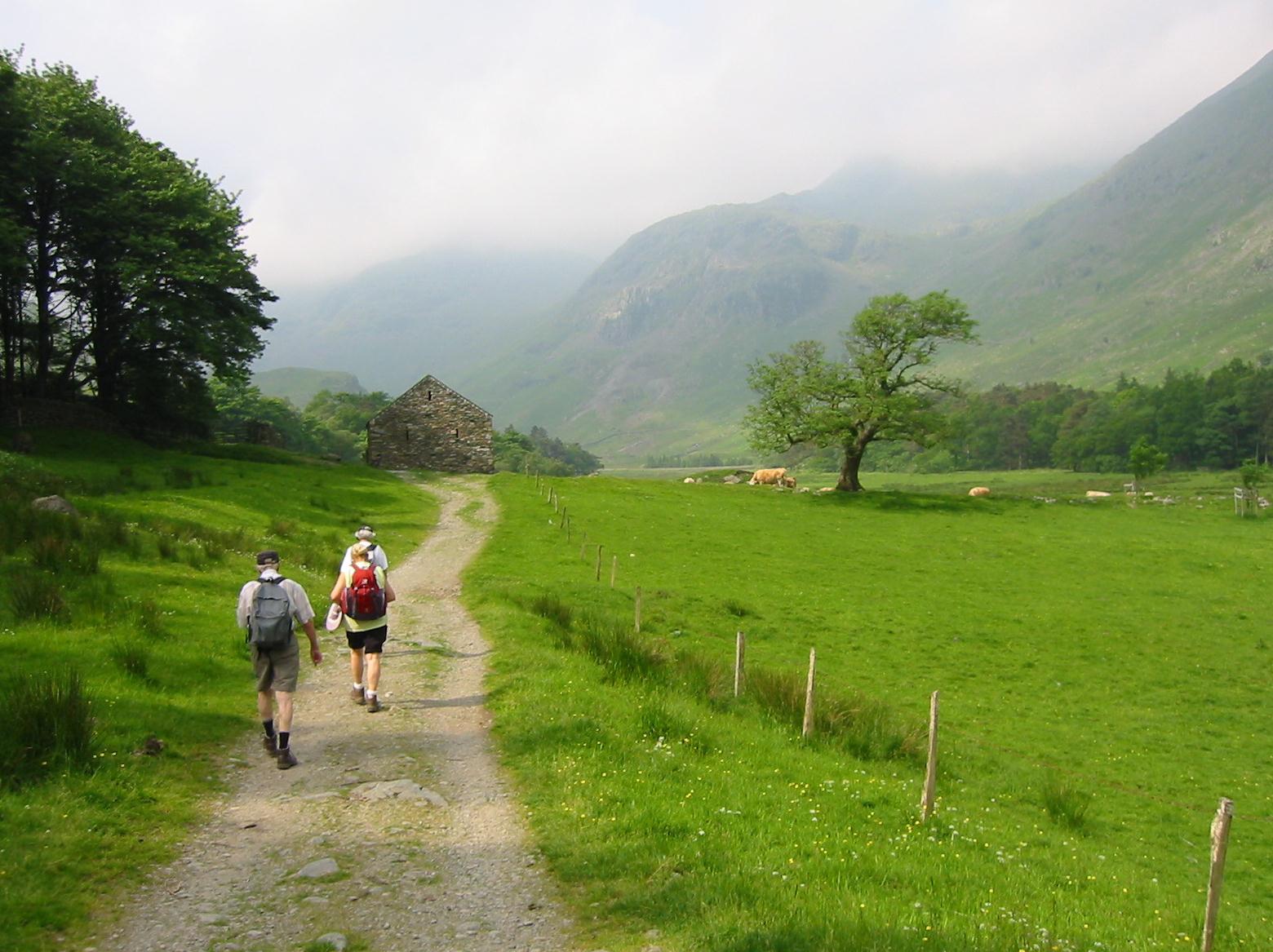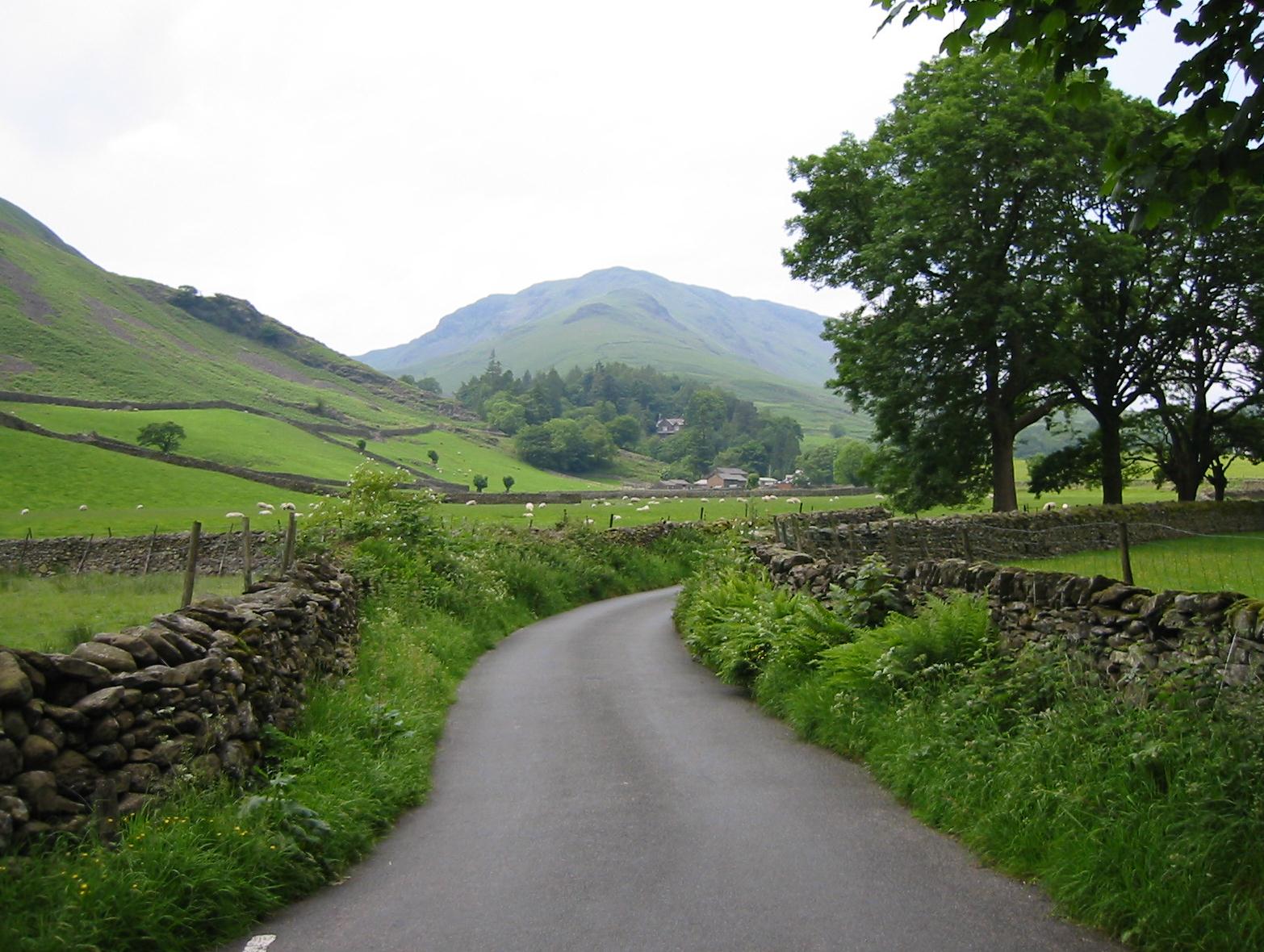June 19, 2005: Patterdale to Grasmere
I think each of us could have used a little more sleep after an energy-sapping day and a somewhat restless night, but we duly reported for breakfast at 8:30. A woman at the next table was phoning her baggage carrier to inquire if three members of her party could ride along to Bampton Grange with the van man today – thus avoiding the traverse of the High Street range. I was going to tell her how, on our walk along the Coast-to-Coast Path two decades ago, I had used a far less strenuous way to reach the Crown and Mitre – but she disappeared before I could do so.
We were handed four packed lunches, left our own bags for the Brigantes people, and exited the White Lion at about 9:30. Tosh made one quick raid on the shop across the street and we began our last full day of walking. Strictly speaking, we were not using Hannon’s suggested route, though we would end up in Grasmere as he does. But the book calls for another strenuous ascent – over Fairfield (at 2863 feet almost 1000 feet higher than yesterday’s summits) – with two lesser summits on the way up, two on the way down and another precipitous descent at the end. It never even came up for discussion that we might undertake such an expedition with our depleted energies and so, by consensus, we adopted an alternative method for reaching the spiritual capital of Lakeland – using our old friend, the Coast-to-Coast Path itself. I had taken the precaution of xeroxing three pages out of Hannon’s revision of Wainwright’s manual.
It was misty about, particularly at the higher elevations – which also argued against the Himalayan option – but there was no rain and it seemed that the sun was trying to break through. We walked north, passing the Patterdale Hotel (which wouldn’t take single night bookings on a weekend, the rogues) and reached the Patterdale church. Then we turned west into the valley of Grisedale Beck, still on tarmac, and, after one false turning into a cul-de-sac, righted ourselves and headed uphill – following a party of six teenage girls with camping equipment. There was a sign to Helvellyn and Grisedale Tarn and I had to explain to one of the young ladies what a tarn was – just as I had to do for so many years for my own young Poe scholars while we were studying The Fall of the House of Usher.
Soon we were making our way along the level bottom of Grisedale – an enchanting vista opening up before us and wildflowers, including banks of rhododendrons, along the roadway. We passed the teenage girls a number of times; they were following a preordained regimen of considerable severity. One of them announced that it was time to get going again and a second complained that they hadn’t had their allotted eight minutes rest yet! They fell behind schedule a bit at the Braesteads turnoff, when one of them tumbled into the beck while filling their canteens. We also met some climbers – about to make a direct assault on the heights on our left. They were worried about heat but we never got high enough to reach the unfiltered sun; indeed, as we passed Nethermostcove Beck and began to rise a bit it became rather grey and chilly.
I had many thoughts, as we passed over one streamlet after another, of my dear Bertie, who used to pause at every one of these water sources for a drink during our descent twenty years ago. He would have had a bit more difficulty now. Margie had joked about the way to Grasmere being paved but, in fact, much of it, we now discovered, was. To ease erosion on this portion of the Wainwright Memorial Highway, trail custodians had imported truckload after truckload of stones, which were embedded in the pathway in such a manner that boots now rarely touched native soil. I didn’t like them; they were much smaller than those used on the North York Moors and not nearly as comfortable to walk on – though I suppose they did their job.
On them we climbed up to Ruthwaite Lodge, turned left at the beck here and, puffing again, made our way slowly up to the basin that held Grisedale Tarn. It was just going noon and so we looked for some shelter against a chilling wind and settled down for lunch with our backs to a boulder. The White Lion prides itself on its packed lunches – with some justification – for we now had before us, in each sack, a sandwich, a pork pie, a bag of crisps, a toffee bar, a juice drink, a tomato, an egg, and an apple. I ate about half of my lunch – and the rest made it back to our kitchen in Maida Vale.
I have never really enjoyed Grisedale Tarn, a cheerless sheet of water without a tree to brighten the vista. We had to splash across the full beck as it exited the lake and then our route continued upward for a short distance and hence over a pass at 1936 feet and into the valley of Tongue Gill. We followed the main route down to a set of falls and thereafter inched our way steeply downward, again on a stony causeway – with a straightforward approach too hazardous in many steep sections and a sideways approach uncomfortable on the feet in the extreme. Far below us we could see Grasmere’s valley, but progress seemed very slow.
We crossed to the right bank of Tongue Gill a mile or so from the end and used a trackway to complete our descent. This was a new route for us; twenty years ago we had used a left bank route almost from the beginning of our ascent. The sun was now burning more brightly in our faces and we were encountering more tourists; one old chap asked how far his party had to go to reach the falls. I told him two miles.
“I’ve got a bad hip,” he explained, “but I’ll make it.”
The descent seemed to go on forever but at last we reached the A591 Keswick Road and we could see the first buildings of Grasmere off to our left. I remembered that Wainwright had disdained the use of the highway in favor of the much quieter lane from Low Mill Bridge, which we now descended to on tarmac. The scene was idyllic as we turned south, rising slightly to Underhelm Farm and continuing forward, amid cottages, gardens and trees in full leaf, as far as the Easedale Road. Here we crossed the Goody Bridge and chose another lane that lead directly to the heart of the village. There was a parallel path for a while but when it started to curve away from our objective I placed us back on the road. We hadn’t far to go, circling around the green before discovering our Harwood Hotel on the main road. It was 3:30 and we had walked nine miles.
Our packs were waiting for us in the vestibule and we were shown to our rooms. The Lees and Margie had rooms on the second floor, sharing a loo and a bathroom, and I had a room on the first floor, with my own locked w.c. and shower room across the hall. We didn’t do much now but throw off our daypacks and repair to the Lamb pub in the Best Western Hotel – the finest in Rasmere (or so its sign said) across the way. I had a most welcome pint.
I had mentioned to Tosh and Margie that they still had time to visit Dove Cottage, but they seemed more interested in shopping. I too bought something, a new pair of rain pants – having discovered that the crotch of my old pair had now rotted out completely. We enquired about eating places and our proprietor recommended an Italian restaurant and supplied a telephone number. Then we all had a rest (I had a shower) until 6:50 when we began a march past the camping exhibition and out to a roundabout where we followed the Ambleside Road south, past our restaurant, and on to the Prince of Wales (formerly The Thistle) – a hotel that actually overlooked Grasmere itself. Here we got our pre-dinner drinks, just before the Germans and the Swedes arrived, and had a relaxing moment before returning to the Villa Colombina.
The place wasn’t crowded though the waitress (who had two other jobs) was a bit harried. Margie and I had pasta (mine with pesto) and the Lees risotto. There was some debate over the spider plants hanging from the chandeliers; they proved to be fake – “Who’d have time to water them?” another waitress said. The meal was pleasant enough, though there was some cultural confusion as the only tape possessed by the staff offered the greatest hits of the Gypsy Kings. After dessert we walked back by way of Dove Cottage. Here Harold had an epiphany – “Villa Colombina means Dove Cottage.” Later I looked it up. He was right.
I called Dorothy for the last time (she reported happiness with the new color of the living room) and we all had an early night.
To continue with the next stage of our walk you need:



